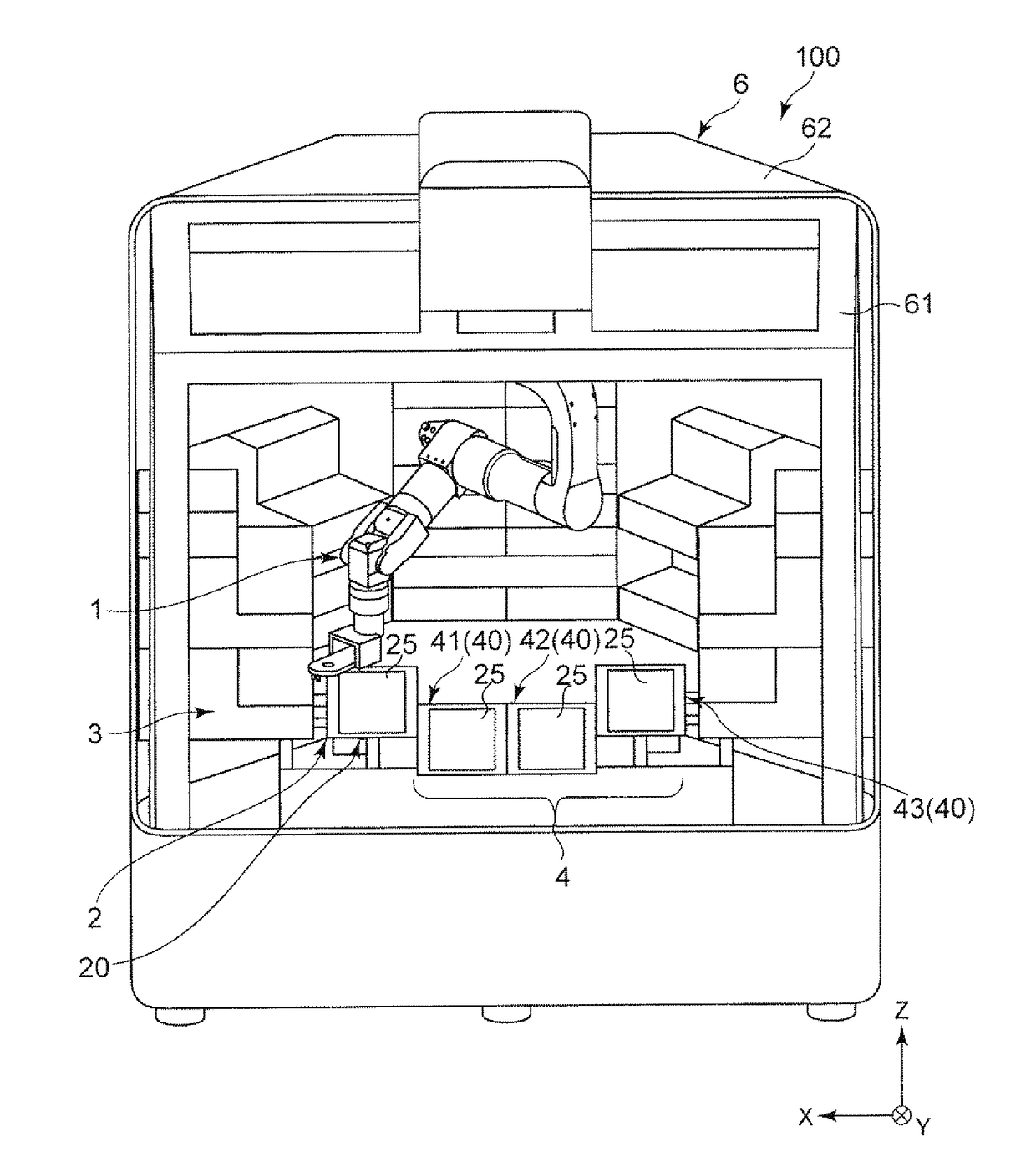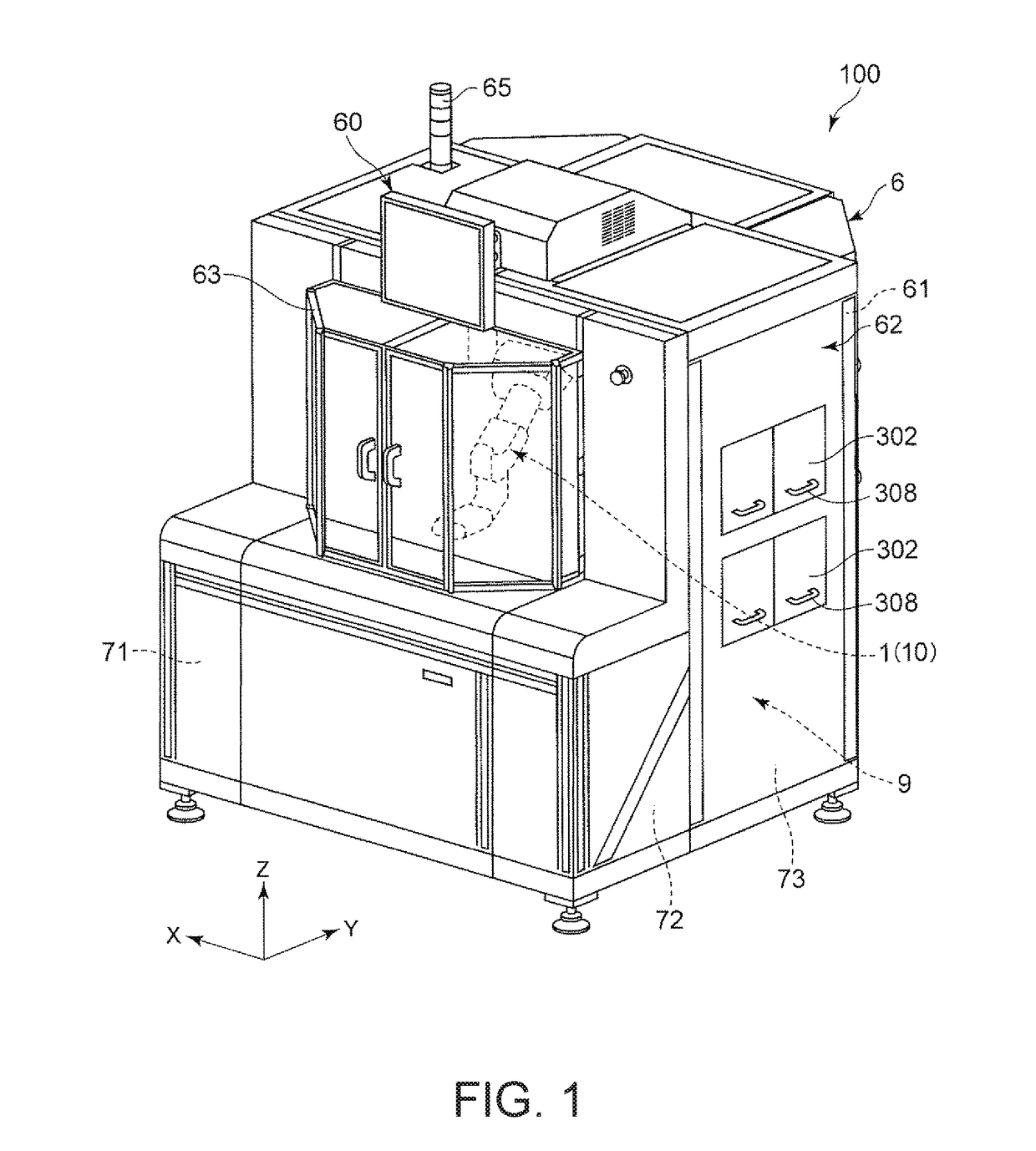Robot system
a robot and robot technology, applied in the field of robot systems, can solve problems such as difficulty in increasing throughput, and achieve the effect of accurately performing the holding and releasing of objects by the robot and accurately calculating the teaching points
- Summary
- Abstract
- Description
- Claims
- Application Information
AI Technical Summary
Benefits of technology
Problems solved by technology
Method used
Image
Examples
first embodiment
1. Configuration of a Robot System
[0100]FIG. 1 is a perspective view of a robot system according to a first embodiment of the invention viewed from the front side. FIG. 2 is a perspective view of the robot system shown in FIG. 1 viewed from the back side. FIG. 3 is a left side view of the robot system shown in FIG. 1. FIG. 4 is a perspective view showing the inside of the robot system shown in FIG. 1. FIG. 5 is a plan view showing the inside of the robot system shown in FIG. 1. FIG. 6 is a block diagram of the robot system shown in FIG. 1. FIG. 7 is a plan view showing a placing member included in a supply section shown in FIG. 1. FIG. 8 is a perspective view showing a test unit shown in FIG. 1. FIG. 9 is a side view of a test section shown in FIG. 1. FIG. 10 is a plan view of a test table shown in FIG. 8. FIG. 11 is a diagram showing a state in which the test table shown in FIG. 8 is drawn out to the outside of a housing. Note that, in FIG. 7, illustration of a socket 307 included ...
second embodiment
[0320]A second embodiment of the invention is explained.
[0321]FIG. 46 is a side view showing a test section included in a robot system according to the second embodiment of the invention. FIG. 47 is a diagram showing an example of an object tested in the test section shown in FIG. 46.
[0322]The robot system according to this embodiment is the same as the robot system in the first embodiment except that the configuration of the test section is different. Note that, in the following explanation, concerning the second embodiment, differences from the first embodiment are mainly explained. Explanation of similarities is omitted.
[0323]The test section 300 in this embodiment includes, as shown in FIG. 46, a socket 309 including a concave section 3091 functioning as an insertion section into which the object 80 can be inserted. The concave section 3091 is opened to the right side in FIG. 46. The socket 309 is formed in, for example, a flat shape and is suitable for a test of an object, a te...
third embodiment
[0325]A third embodiment of the invention is explained.
[0326]FIG. 48 is a schematic diagram of the inside of a robot system according to the third embodiment of the invention viewed from the upper side.
[0327]The robot system according to this embodiment is the same as the robot systems in the embodiments explained above except that the configuration of a test section is different. Note that, in the following explanation, concerning the third embodiment, differences from the embodiments explained above are mainly explained. Explanation of similarities is omitted.
[0328]The test unit 3 in this embodiment includes eight test sections 300. Specifically, the first test section group 31 includes two first test sections 310 (test sections 300), the second test section group 32 includes two second test sections 320 (test sections 300), the third test section group 33 includes two third test sections 330 (test sections 300), and the fourth test section group 34 includes two fourth test sectio...
PUM
 Login to View More
Login to View More Abstract
Description
Claims
Application Information
 Login to View More
Login to View More - R&D
- Intellectual Property
- Life Sciences
- Materials
- Tech Scout
- Unparalleled Data Quality
- Higher Quality Content
- 60% Fewer Hallucinations
Browse by: Latest US Patents, China's latest patents, Technical Efficacy Thesaurus, Application Domain, Technology Topic, Popular Technical Reports.
© 2025 PatSnap. All rights reserved.Legal|Privacy policy|Modern Slavery Act Transparency Statement|Sitemap|About US| Contact US: help@patsnap.com



